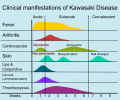Wikisage, the free encyclopedia of the second generation, is digital heritage
Kawasaki disease
Kawasaki disease (KD) was first reported in 1967 by T. Kawasaki , a Japanese pediatrician.1 The first Korean KD patient was reported in 1973.2 Since then, the incidence of this disease has increased continuously. KD is characterized with acute systemic vasculitis that occurs predominantly in children between 6 months to 5 years of age. Although the clinical symptoms of KD are well characterized, the causes of this disease are not yet known. For this reason, KD is usually diagnosed by clinical symptoms, such as a fever for 5 days or more, bilateral nonpurulent conjunctival congestion, changes of the lips and oral mucosa, polymorphous exanthema along the trunk, changes of the peripheral extremities and subsequent desquamation of finger tips, and nonpurulent cervical lymphadenopathy over 1.5 cm in size [1]
High-dose of aspirin can agravate further including sensorineural hearing loss. Various authors uggested that the ototoxicity of the high-dose aspirin that was used for the treatment of the acute phase might cause sensorineural hearing loss.[2]
-
Maen K Househ
-
Links
Park et al.Sensorineural hearing loss in patients with Kawasaki disease Korean J Pediatr. 2015 Nov; 58(11): 434
Chest pain
Aneurisma
Ghareep et al 2015 [http://www.ncbi.nlm.nih.gov/pmc/articles/PMC4671404/pdf/poljradiol-80-526.pdf Kawasaki Disease: Diagnosis and Follow-Up by CT Coronary Angiography with the Use of 128-Slice Dual
Source Dual Energy Scanner. A Case Report]Pol J radiol.

